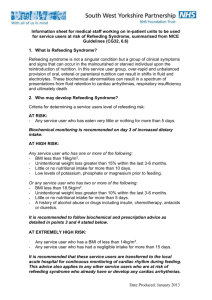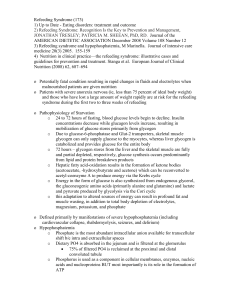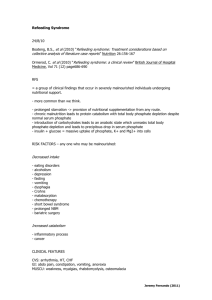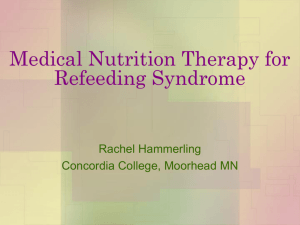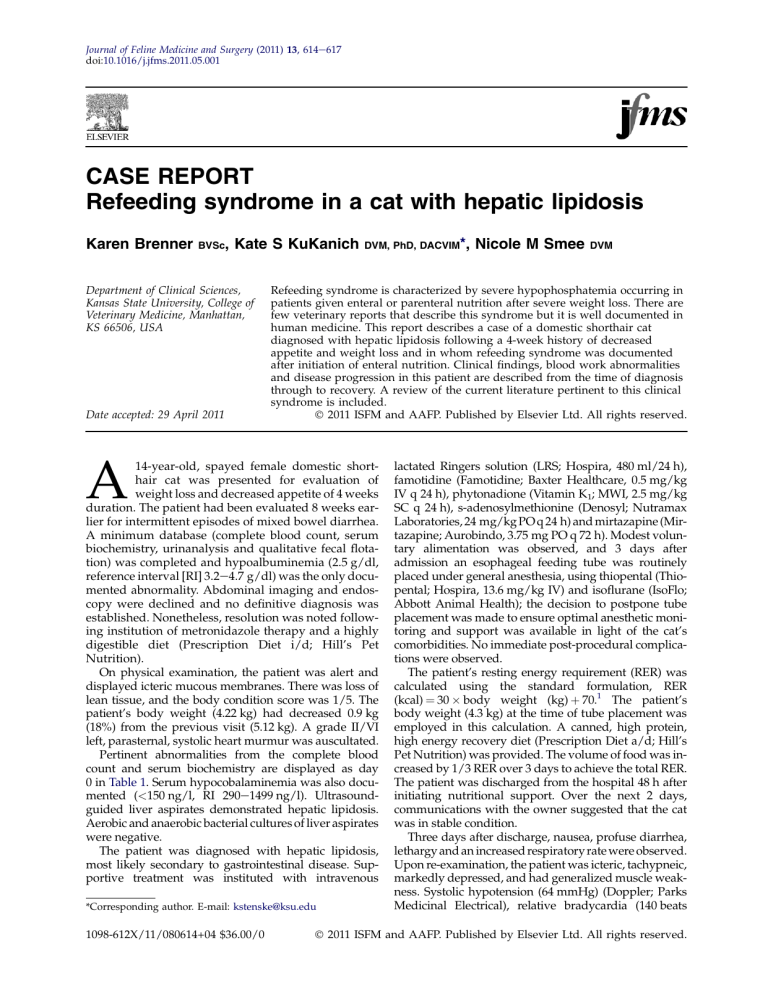
Journal of Feline Medicine and Surgery (2011) 13, 614e617 doi:10.1016/j.jfms.2011.05.001 CASE REPORT Refeeding syndrome in a cat with hepatic lipidosis Karen Brenner BVSc, Kate S KuKanich Department of Clinical Sciences, Kansas State University, College of Veterinary Medicine, Manhattan, KS 66506, USA Date accepted: 29 April 2011 DVM, PhD, DACVIM*, DVM Refeeding syndrome is characterized by severe hypophosphatemia occurring in patients given enteral or parenteral nutrition after severe weight loss. There are few veterinary reports that describe this syndrome but it is well documented in human medicine. This report describes a case of a domestic shorthair cat diagnosed with hepatic lipidosis following a 4-week history of decreased appetite and weight loss and in whom refeeding syndrome was documented after initiation of enteral nutrition. Clinical findings, blood work abnormalities and disease progression in this patient are described from the time of diagnosis through to recovery. A review of the current literature pertinent to this clinical syndrome is included. Ó 2011 ISFM and AAFP. Published by Elsevier Ltd. All rights reserved. A 14-year-old, spayed female domestic shorthair cat was presented for evaluation of weight loss and decreased appetite of 4 weeks duration. The patient had been evaluated 8 weeks earlier for intermittent episodes of mixed bowel diarrhea. A minimum database (complete blood count, serum biochemistry, urinanalysis and qualitative fecal flotation) was completed and hypoalbuminemia (2.5 g/dl, reference interval [RI] 3.2e4.7 g/dl) was the only documented abnormality. Abdominal imaging and endoscopy were declined and no definitive diagnosis was established. Nonetheless, resolution was noted following institution of metronidazole therapy and a highly digestible diet (Prescription Diet i/d; Hill’s Pet Nutrition). On physical examination, the patient was alert and displayed icteric mucous membranes. There was loss of lean tissue, and the body condition score was 1/5. The patient’s body weight (4.22 kg) had decreased 0.9 kg (18%) from the previous visit (5.12 kg). A grade II/VI left, parasternal, systolic heart murmur was auscultated. Pertinent abnormalities from the complete blood count and serum biochemistry are displayed as day 0 in Table 1. Serum hypocobalaminemia was also documented (<150 ng/l, RI 290e1499 ng/l). Ultrasoundguided liver aspirates demonstrated hepatic lipidosis. Aerobic and anaerobic bacterial cultures of liver aspirates were negative. The patient was diagnosed with hepatic lipidosis, most likely secondary to gastrointestinal disease. Supportive treatment was instituted with intravenous *Corresponding author. E-mail: kstenske@ksu.edu 1098-612X/11/080614+04 $36.00/0 Nicole M Smee lactated Ringers solution (LRS; Hospira, 480 ml/24 h), famotidine (Famotidine; Baxter Healthcare, 0.5 mg/kg IV q 24 h), phytonadione (Vitamin K1; MWI, 2.5 mg/kg SC q 24 h), s-adenosylmethionine (Denosyl; Nutramax Laboratories, 24 mg/kg PO q 24 h) and mirtazapine (Mirtazapine; Aurobindo, 3.75 mg PO q 72 h). Modest voluntary alimentation was observed, and 3 days after admission an esophageal feeding tube was routinely placed under general anesthesia, using thiopental (Thiopental; Hospira, 13.6 mg/kg IV) and isoflurane (IsoFlo; Abbott Animal Health); the decision to postpone tube placement was made to ensure optimal anesthetic monitoring and support was available in light of the cat’s comorbidities. No immediate post-procedural complications were observed. The patient’s resting energy requirement (RER) was calculated using the standard formulation, RER (kcal) ¼ 30 body weight (kg) þ 70.1 The patient’s body weight (4.3 kg) at the time of tube placement was employed in this calculation. A canned, high protein, high energy recovery diet (Prescription Diet a/d; Hill’s Pet Nutrition) was provided. The volume of food was increased by 1/3 RER over 3 days to achieve the total RER. The patient was discharged from the hospital 48 h after initiating nutritional support. Over the next 2 days, communications with the owner suggested that the cat was in stable condition. Three days after discharge, nausea, profuse diarrhea, lethargy and an increased respiratory rate were observed. Upon re-examination, the patient was icteric, tachypneic, markedly depressed, and had generalized muscle weakness. Systolic hypotension (64 mmHg) (Doppler; Parks Medicinal Electrical), relative bradycardia (140 beats Ó 2011 ISFM and AAFP. Published by Elsevier Ltd. All rights reserved. Refeeding syndrome in a cat with hepatic lipidosis 615 Table 1. Complete blood count and serum biochemistry abnormalities. Values given in bold are outside the RI. Parameter White blood cell count Hematocrit, spun Glucose Creatinine Blood urea nitrogen Albumin Sodium Potassium Chloride Phosphorus Magnesium, free Alanine transaminase Alkaline phosphatase Bilirubin Cholesterol RI RI* Day 0 Day 8 Day 9* Day 10 5.5e19.5 K/ml 30e45% 60e133 mg/dl 0.8e2.1 mg/dl 16e35 mg/dl 3.2e4.7 g/dl 150e163 mmol/l 3.6e5.5 mmol/l 116e130 mmol/l 2.7e6.5 mg/dl 0.77e1.28 mg/dl 45e217 U/l 11e95 U/l 0e0.4 mg/dl 75e271 mg/dl e e 70e119 mg/dl e 17e37 mg/dl e 152e162 nmol/l 3.2e5.0 nmol/l 113e126 nmol/l e 0.77e1.28 mg/dl e e e e 4.9 36 99 1 16 2.8 149 4.4 120 3.5 np 71 607 4.6 168 25.3 22 303 1.3 51 2.8 129 3.3 84 6.0 np 76 522 10.8 256 np 19 175* 0.9 17* np 136.4* 3.5* 108.9* np 1.1* np np np np 10.9 17 234 0.5 9 2.1 138 4.2 107 1.7 np 81 490 8.6 196 *Indicates different RI for sample. np ¼ not performed. per min) with weak femoral pulses and mild hypothermia (98.1 F) were documented. Oxygen responsive hypoxemia (90%) was recorded with pulse oximetry. A moderate normocytic, normochromic anemia and acute inflammatory leukogram with mild toxic change were recorded. Pre-regenerative hemolysis due to oxidative damage or gastrointestinal ulceration was considered a plausible explanation for the anemia as well as anemia of chronic inflammatory disease.2 Gastrointestinal bacterial translocation, bacterial cholangiohepatitis, and pneumonia were considered for the inflammatory leukogram. Moderate hyperglycemia was suspected to have been induced by stress, and the marked hyperbilirubinemia was considered to be a consequence of hemolysis and/or hepatic dysfunction. Despite the absence of urine evaluation, it was hypothesized that the azotemia was most likely a reflection of hypovolemia. The remaining abnormalities on day 8 (Table 1), hyponatremia and hypochloremia, were attributed to loss of electrolyterich gastrointestinal fluid. Thoracic radiographs were unremarkable, and echocardiography suggested senile remodelling or mild hypertrophic cardiomyopathy as well as mild diastolic abnormalities. Active surface rewarming was undertaken and the patient was treated with intravenous lactated Ringers solution (LRS; Hospira); potassium chloride (KCl; Hospira) supplementation was adjusted based on serial serum values (Table 1). Maropitant (Cerenia; Pfizer Animal Health, 1 mg/kg SC q 24 h) was administered to control nausea. Famotidine (Famotidine; Baxter Healthcare, 0.5 mg/kg IV q 24 h) was initiated because of the possibility of gastrointestinal ulceration suggested by the increased blood urea nitrogen to creatinine ratio as well as moderate anemia. Furthermore, ampicillin/sulbactam (Unasyn; Pfizer Animal Health, 22 mg/kg IV q 8 h) was provided because despite negative culture results, bacterial cholangiohepatitis was still considered a relevant differential diagnosis and the patient’s history documented a positive response to antibiotic therapy. Cyanocobalamin (Vitamin B12; APP Pharmaceuticals, 250 mg SC q 7 days) was also administered. An inspired oxygen fraction of 40% was provided using an oxygen cage. Nutritional supplementation was withheld for 19 h by which time the patient’s potassium was within the RI and the hyponatremia and hypochloremia were improved. Approximately 38 h after re-admission, marked hypophosphatemia and hemolytic anemia were recorded (day 10, Table 1). The anemia was characterized by moderate Heinz bodies, basophilic stippling, and occasional polychromasia. Weight gain (200 g, 5%) and resolution of azotemia were also documented at this time. Although severe lipidosis and other primary liver diseases were initially considered differentials for the increasing bilirubin and oxidative damage, the combination of the patient’s nutritional history, hypophosphatemia, hypokalemia and hemolytic anemia was most consistent with a diagnosis of refeeding syndrome. Supplemental phosphorus was provided using potassium phosphate (KPO4; American Regent). Feeding began at 1/5 RER and was increased gradually over 5 days to achieve the total RER. Again, a canned, high protein, high energy recovery diet was employed (Prescription Diet a/d; Hill’s Pet Nutrition). The patient was weaned off oxygen and discharged on day 15. The esophageal feeding tube was removed on day 46 when a complete recovery was achieved. The patient is currently fed ad libitum with a dry, high protein, low carbohydrate diet (DM Dietetic Management Feline Formula; Nestlé Purina PetCare Company); this dietary choice was dictated by the needs of another cat in the household. Since the time of discharge an isolated episode of acute vomiting and 616 K Brenner et al inappetence has been recorded; a highly digestible diet was provided at this time (Prescription Diet i/d; Hill’s Pet Nutrition) and the signs resolved in 2 days. Refeeding syndrome is defined as the constellation of metabolic and physiologic derangements associated with caloric repletion of the starved patient.311 Classically, refeeding syndrome is characterized by the development of severe hypophosphatemia following the introduction of enteral or parenteral nutrition. Refeeding syndrome can also variably include hypokalemia, hypomagnesemia, vitamin deficiencies, fluid intolerance and glucose intolerance.512 It is believed that refeeding syndrome is a consequence of the body’s inability to rapidly adapt from a chronically catabolic state to an anabolic state. Starvation can lead to villous atrophy and compromised absorptive capacity may explain the severe diarrhea observed in the patient described here. In response to anabolism and heightened by the release of insulin, cellular uptake of phosphorus and inorganic phosphates occurs, leading to hypophosphatemia. Phosphorus and phosphates are required for the synthesis of ATP, DNA, RNA, proteins and 2,3-DPG, as well as for phosphorylation of glucose. Phosphorus depletion leads to a reduction in erythrocyte ATP concentration, failure of actin and myosin, altered erythrocyte membrane lipids and consequently, hemolytic anemia.13,14 Heinz body formation contributes to anemia and occurs due to impaired phosphorylation of glucose in the pentose monophosphate pathway.14 The patient described herein showed evidence of hemolytic anemia and Heinz body formation, and although these changes can result directly from lipidosis and toxin or drug exposure, such etiologies were considered less likely than refeeding syndrome. Additional manifestations of hypophosphatemia may include increased susceptibility to infection, inadequate oxygen delivery to tissues, rhabdomyolysis, impaired diaphragmatic contractility, decreased sarcomere contractility and encephalopathy. Impaired oxygen delivery from anemia and diaphragmatic contractility may have led to this patient’s tachypnea and hypoxemia. In this case, hypophosphatemia was not apparent until 38 h after presentation; however, the presence of a hypophosphatemic state was arguably masked by the reduction in glomerular filtration rate that accompanies volume contraction, which this patient had. This interpretation is supported by the 60% reduction in creatinine that was documented between the value recorded on admission for refeeding syndrome (day 8, Table 1) and the value on the day that volume repletion was accomplished, when hypophosphatemia became biochemically apparent (day 10, Table 1). Ideally, direct estimation of the patient’s glomerular filtration rate would have been conducted to confirm this hypothesis. The provision of carbohydrates and amino acids to starved patients promotes anabolism and glycosis leading to intracellular translocation of phosphorus, potassium and magnesium and this is further augmented by the increased release of insulin which is suppressed during states of weight loss and hepatic lipidosis.4,15 For these reasons, a low carbohydrate, high protein and high energy diet is recommended. Hypokalemia may provoke glucose intolerance, neuromuscular weakness, ileus, polyuria and polydipsia, respiratory depression and cardiac arrhythmias. Our case demonstrated hypokalemia, and this derangement may have contributed to the neuromuscular weakness and respiratory depression observed; this was supported by the notable clinical response to aggressive potassium supplementation. Magnesium is mandatory for cellular processes involving ATP, and hypomagnesemia is an important mediator of hypocalcemia, refractory hypokalemia, cardiac arrhythmias and neuromuscular weakness.5 Hypomagnesemia is a variable finding in patients with refeeding syndrome. The remaining electrolyte abnormalities, marked hyponatremia and hypochloremia, were most likely the consequence of electrolyte-rich insensible fluid loss in diarrhea. These abnormalities improved with intravenous fluid therapy; however, more aggressive therapy may have been indicated because such derangements can contribute substantially to generalized weakness. Thiamine (vitamin B1) is an essential cofactor in a number of reactions involved in carbohydrate metabolism, and it may become depleted when cellular demand increases in response to refeeding with carbohydrates.6,8,10,11 Thiamine deficiency can be objectively diagnosed by demonstrating deficiencies of erythrocyte transketolase or thiamine-phosphorylated esters; however, thiamine deficiency is more commonly diagnosed by subjectively documenting signs consistent with Wernicke’s encephalopathy and a response to supplementation. Many features of thiamine deficiency-associated-encephalopathy (ataxia, vestibular dysfunction and visual disturbances) are indistinguishable from those induced by hypophosphatemia and hypokalemia, rendering it difficult to define its contribution to refeeding syndrome. It’s important to note that thiamine supplementation is common in commercial pet foods1 and clinical deficiency is rarely documented in companion animals. Hyperglycemia documented in patients with refeeding syndrome may reflect the introduction of glucose into a system adapted to fat metabolism. Hyperglycemia can lead to disrupted neutrophil function and hyperosmolar hyperglycemic non-ketotic coma. The cat in this report had only moderate and transient hyperglycemia and although this abnormality was initially attributed to stress it may also be an illustration of the pathophysiology of refeeding syndrome in play. There is a paucity of reports documenting refeeding syndrome in the veterinary literature, and the incidence is currently unknown. Veterinary literature describing the metabolic complications associated with parenteral feeding is available;12,16,17 however, similar reports focused on enteral nutrition are limited. One publication describes hypophosphatemia associated with enteral alimentation in 2% of feline patients during an 18-month period.13 To the authors’ knowledge, the three manuscripts that specifically identify refeeding syndrome in Refeeding syndrome in a cat with hepatic lipidosis companion animals are restricted to feline patients.12,13,18 The authors suggest that this may reflect the highly specific nutritional requirements of this species, such as the need for high dietary protein and thiamine as well as essential amino acids. Furthermore, due to their low level of hepatic glucokinase, cats may be more susceptible to the development of hyperglycemia and subsequent insulin release after nutritional support is instituted. Early identification of patients at risk for refeeding syndrome is a major focus in human nutrition,10,13,15,19 and experts advocate for correction of electrolyte deficiencies prior to initiating feeding as well as administration of a loading dose of thiamine.3,5,11 When nutritional support is instituted, no greater than 20% of the basal energy expenditure is provided on the first day and supplementation is increased over 4e10 days.5,11 Recommended daily monitoring parameters include body weight, urine output, plasma electrolytes, electrocardiographic changes and maintenance of serum glucose within a narrow range.5,11 One veterinary report specifically lists hepatic lipidosis as a risk factor for the development of refeeding syndrome.10 Interestingly, in the study describing enteral nutrition induced hypophosphatemia in cats, 5/9 cases were diagnosed with hepatic lipidosis.13 Similarly, humans with cirrhosis and hepatic insufficiency are more likely to develop hypophosphatemia with glucose infusions.13 Why the patient in this report developed refeeding syndrome is unknown. The nutritional plan that was implemented adhered to contemporary recommendations not to exceed the patient’s RER and to increase the daily caloric load slowly over 72 h.1 Perhaps following recommendations from the human literature whereby the patient’s basal energy requirement rather than the RER is used in addition to increasing the daily caloric intake over 4e10 days instead of 3 days, would have prevented this complication. Finally, high risk patients should be identified prior to initiating nutritional support and electrolyte values (potassium, phosphorus, magnesium) and packed red cell volume monitoring should be performed daily until total RER is achieved in order to minimize the risk of refeeding syndrome. References 1. Gross KL, Jewell DE, Yamka RM, et al. Macronutrients. In: Hand MS, Thatcher CD, Remillard RL, Roudebush P, Novotny BJ, eds. Small animal clinical nutrition. 5th edn. Topeka: Mark Morris Institute, 2010: 60e133. 617 2. McMichael M. Oxidative stress, antioxidants, and assessment of oxidative stress in dogs and cats. J Am Vet Med Assoc 2007; 231: 712e20. 3. Solomon S, Kirby D. The refeeding syndrome: a review. J Parenter Enteral Nutr 1990; 14: 90e7. 4. Miller C, Bartges J. Refeeding syndrome. In: Bonagura J, ed. Kirk’s current veterinary therapy. 13th edn. Philadelphia: WB Saunders, 2000: 87e9. 5. Boateng AA, Sriram K, Meguid MM, Crook M. Refeeding syndrome: treatment considerations based on collective analysis of literature case reports. Nutrition 2010; 26: 156e67. 6. Crook MA, Hally V, Panteli JV. The importance of the refeeding syndrome. Nutrition 2001; 17: 632e7. 7. Marinella MA. Refeeding syndrome and hypophosphatemia. J Intensive Care Med 2005; 20: 155e9. 8. Kraft MD, Btaiche IF, Sacks GS. Review of the refeeding syndrome. Nutr Clin Pract 2005; 20: 625e33. 9. Marinella MA. The refeeding syndrome and hypophosphatemia. Nutr Rev 2003; 61: 320e3. 10. Lippo N, Byers C. Hypophosphatemia and refeeding syndrome. VetLearn.com Standards of Care, 2008. http://www.vetlearn.com/SearchResults.aspx?Search¼ refeedingþsyndrome [accessed 10.08.10]. 11. Stanga Z, Brunner A, Leuenberger M, et al. Nutrition in clinical practice e the refeeding syndrome: illustrative cases and guidelines for prevention and treatment. Eur J Clin Nutr 2008; 62: 687e94. 12. Crabb S, Freeman L, Chan D, Labato M. Retrospective evaluation of total parenteral nutrition in cats: 40 cases (1991e2003). J Vet Emerg Crit Care 2006; 16: S21e6. 13. Justin R, Hohenhaus A. Hypophosphatemia associated with enteral alimentation in cats. J Vet Intern Med 1995; 9: 228e33. 14. Adams L, Hardy R, Weiss D, Bartges J. Hypophosphatemia and hemolytic anemia associated with diabetes mellitus and hepatic lipidosis in cats. J Vet Intern Med 1993; 7: 266e71. 15. Biourge V, Nelson R, Feldman E, Willits N, Morris J, Rogers Q. Effect of weight gain and subsequent weight loss on glucose tolerance and insulin response in healthy cats. J Vet Intern Med 1997; 11: 86e91. 16. Afzal NA, Addai S, Fagbemi A, Murch S, Thomson M, Heuschkel R. Refeeding syndrome with enteral nutrition in children: a case report, literature review and clinical guidelines. Nutrition 2002; 21: 515e20. 17. Chan D, Freeman L, Labato M, Rush J. Retrospective evaluation of partial parenteral nutrition in dogs and cats. J Vet Intern Med 2002; 16: 440e5. 18. Reuter J, Marks S, Rogers Q, Farver T. Use of total parenteral nutrition in dogs: 209 cases (1988e1995). J Vet Emerg Crit Care 1998; 8: 201e13. 19. Armitage-Chan E, O’Toole T, Chan D. Management of prolonged food deprivation, hypothermia, and refeeding syndrome in a cat. J Vet Emerg Crit Care 2006; 16: S34e41. Available online at www.sciencedirect.com
